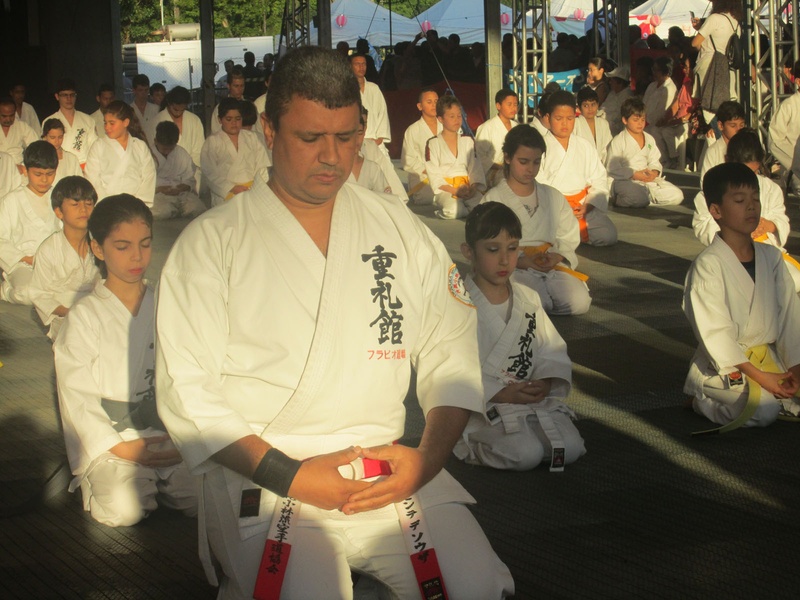He discovered martial arts through his father who practiced judo and began training at the age of 10. He earned his black belt diploma in Brazil and had the incredible opportunity and experience of training, seminars and internships in Okinawa, where he received his teaching certificate from the Okinawa Association.
Afterwards, he also received the 7th dan black belt diploma (senior teacher) and the title of shihan (master) in Okinawa.
This is the trajectory of Flavio Vicente de Souza, 43 years old, a firefighter with the Military Police of the State of São Paulo who is now president of the Okinawa Shorinryu Karatedo Jyureikan and Kobudo Jinbunkai do Brasil association.
The master of karate and kobudo from Okinawa talks about these arts and the interest and practice among Brazilians.
Kobudo and Karatedo
Karate (“way of free hands”) and kobudo (“ancestral martial art”) emerged in Okinawa almost at the same time because of the law that prohibited the possession of weapons in the kingdom of Ryukyu (former name of Okinawa), with the aim to restore peace and prosperity in the region.
Peasants and fishermen were left defenseless against Japanese samurai and other elite classes, as they were the only ones with weapons. Furthermore, they were also attacked by pirates and bandits. It was at this time that the population began to combine knowledge of Chinese fighting arts with the agricultural and fishing tools used in their daily lives. Thus, Ryukyu Kobudo was born.

The most common weapons in kobudo are the bo (1.80 to 2 meter stick), the tonfa (personal defense stick) and nunchaku (a weapon made up of two small sticks connected at one end by a rope or chain).
In Okinawa Kobudo the names of leg positions and strikes are the same as those used in karate . Traditional karate is competition karate that focuses on training to score in championships. The modality originating from Okinawa – also known as three-dimensional karate , in which the mind, spirit and physique are trained – focuses on personal defense and can be considered a lifestyle.
Practice in Brazil
The tradition of karate was brought by pioneer immigrants in 1908, but training was only carried out within the former Japanese colonies. The first teacher to create a karate academy ( dojo ) in Brazil was Mitsuke Harada, in the center of São Paulo, in 1956. Later, they appeared in other states and the martial art soon gained many followers.
The first officially registered association was ABK (Brazilian Karate Association) whose leader was Shikan Akamine, who was also the precursor of kobudo in Brazil. Thus, other masters followed the example of Harada and Akamine and created new karate associations, such as master Yoshide Shinzato.
Both karate and kobudo were created for all audiences, but mainly as a balanced lifestyle that emphasizes courtesy, respect, humility, character development, control of the spirit of aggression and several other qualities that the practitioner gains throughout years of training. Therefore, in Okinawa these arts are considered a cultural treasure.
“Our concern is to maintain traditional Okinawan karate and not forget its origin and objectives. In Brazil, especially, it is of great importance because it is a physical activity and martial art that teaches children and young people to have a good character, with ethical principles to form a good society.” Therefore, the Okinawa Shorinryu Karatedo Jyureikan and Kobudo Jinbunkai do Brasil association is directly affiliated with Okinawa, with which it maintains direct exchange and has the objective of “forming champions for life and not just for competitions”.
In Brazil, the practice “unfortunately” is only aimed at competitions, without taking into account the principles of martial arts. Souza believes that 60% of dojos are concerned about creating champions for tournaments.
In Japan, the practice is aimed at mental, spiritual, physical development and personal defense.
“An art for life”
“I became interested in karate because of the philosophy, culture and mainly the self-defense method. At the time [when I was a child and started training] I was very weak and always got beaten up by kids [laughs] at school. So karate made me have self-confidence!” For the master, it is “an art for life”.
Karate and kobudo are martial arts that emerged in Japan and were spread throughout the world. Currently, most practitioners are foreigners.
Despite this, the professor says that in Brazil he suffered a bit of prejudice when he was appointed by Okinawa to be president of the association with the aim of promoting karate and kobudo in associations of Japanese provinces ( kenjinkai ) and within the Japanese-Brazilian community, like master percussionists did in the 1960s.
Later, because of trips to Japan, including Okinawa, he specialized in culture and also in Japanese. Souza wanted to show the importance of practicing karate and maintaining the tradition of the martial art. “In Okinawa, foreigners ( gaijin ) who do this type of work have great support, respect and admiration”, he explains.
The profile of Brazilian practitioners
Before the 1950s, the practice of karate and even judo only took place within the Japanese-Brazilian community. Then, from 1960 to 1970, 50% of practitioners were Nikkei .
Some pioneering masters like Akamine and Shinzato opened up the opportunity for non-descendants to practice karate . With this, the martial art began to be known and propagated in Brazil. In the United States, Europe and Latin America there was a very similar phenomenon.
In the case of Brazil, most descendants were forced to train in a martial art and many did it out of obligation and, therefore, when they became of age they gave up. Others trained until they got their black belt or stopped when they entered college.
Today, in the state of São Paulo there are around 340 thousand practitioners and in Brazil as a whole there are almost a million, counting different federations and styles. The World Karate Federation (WKF), recognized by the International Olympic Committee (IOC), estimates approximately 50 million karatekas around the world.
In Brazil, 70% are men and 30% women, in addition, around 15% are Nikkei (in most karate academies this number reaches 3% of the total) and 85% are non-descendants. But in the dojo where Souza teaches there is 20% Nikkei because the association has a partnership with the Okinawa Kenjin Association of Brazil.

“Brazilians really like martial arts, mainly due to the principles of discipline and Japanese culture!”, concludes the teacher, admirer and follower of Okinawan karate .
© 2017 Tatiana Maebuchi






